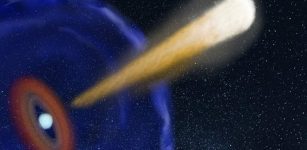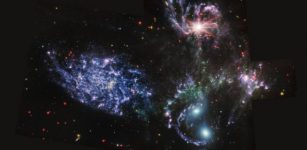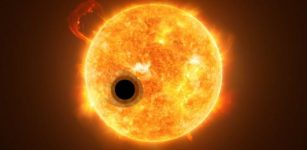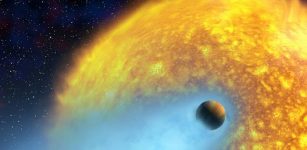Mysterious Blue Ring Nebula And The Fate Of Binary Stars
Eddie Gonzales Jr. – MessageToEagle.com – Astronomers have discovered a rare object called the Blue Ring Nebula, a ring of hydrogen gas with a star at its center.
The properties of this system suggest it is the remnant of two stars meeting their ultimate demise: an inward orbital dance that resulted in the two stars merging.
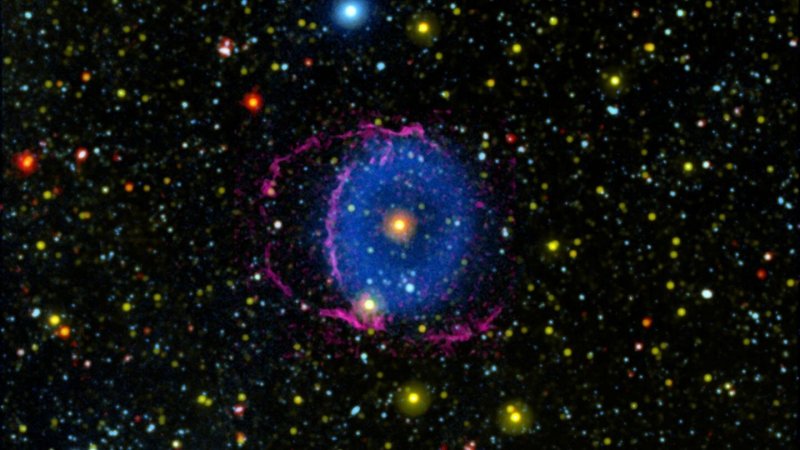 The mysterious Blue Ring Nebula, composed of expanding hydrogen gas (blue) expanding from a central star, which is the remnant core of a stellar merger. Red filaments are shockwave filaments from the merging event. Credit: NASA/JPL-Caltech/M. Seibert (Carnegie Institution for Science)/K. Hoadley (Caltech)/GALEX Team
The mysterious Blue Ring Nebula, composed of expanding hydrogen gas (blue) expanding from a central star, which is the remnant core of a stellar merger. Red filaments are shockwave filaments from the merging event. Credit: NASA/JPL-Caltech/M. Seibert (Carnegie Institution for Science)/K. Hoadley (Caltech)/GALEX Team
The result offers a new window into the fate of many tightly orbiting binary star systems.
In 2004, scientists with NASA’s Galaxy Evolution Explorer spotted an object unlike any they’d seen in our Milky Way Galaxy: a large, faint blob of gas that seemed to have a star at its center. In the ultraviolet wavelengths used by the satellite, the blob appeared blue—though it doesn’t actually emit light visible to the human eye—and careful observations identified two thick rings within it, so the team nicknamed it the Blue Ring Nebula.
Over the next 16 years, they studied it with multiple Earth- and space-based telescopes, but the more they learned about it, the more mysterious it seemed.
“We were in the middle of observing one night, with a new spectrograph that we had recently built, when we received a message from our colleagues about a peculiar object composed of a nebulous gas expanding rapidly away from a central star,” said Princeton’s Guðmundur Stefánsson.
“How did it form? What are the properties of the central star? We were immediately excited to help solve the mystery!”
Most stars in the Milky Way are in binary systems—pairs of stars orbiting each other. If they are close enough together, such systems can meet their demise in a stellar merging event: As stars evolve, they expand, and if they are close enough together, one of the stars can engulf its orbiting companion, causing the companion to spiral inward until the two stars collide. As the companion loses its orbital energy, it can eject material away at high speeds.
“The spectroscopic observations were key in allowing us to understand the object further, from which we see that the central star is inflated, and we see signatures of accretion likely from a surrounding disk of debris,” Stefánsson said.
“Indeed, the spectroscopic data coupled with theoretical modeling shows that the Blue Ring Nebula is consistent with the picture of a merging binary star system, suggesting that the inwards spiraling companion was likely a low-mass star,” said Keri Hoadley, a postdoctoral fellow at Caltech and lead author of the paper.
“The Blue Ring Nebula is rare,” said Hoadley. “As such, it is really exciting that we were able to find it, and we are excited about the possibility of finding more such objects in the future. If so, that would allow us to gain further insights into the remnants of stellar mergers and the processes that govern them.”
Written by Eddie Gonzales Jr. – MessageToEagle.com Staff



